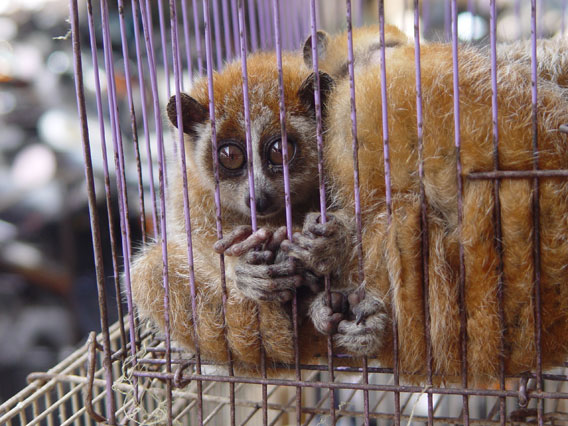
Slow lorises, like these caged individuals, are imperiled in Southeast Asia for the illegal pet trade. In the wild, traders kill loris parents to take their babies. Pet lorises have their teeth pulled out to make them appear ‘cuter’. Photo courtesy of the Wildlife Conservaiton Society (WCS).
Organized criminal syndicates are wiping out some of the world’s most charismatic wildlife to feed a growing appetite for animal parts in East Asia#8212;and so far governments and law enforcement are dropping the ball. This is the conclusion from a new paper in Oryx, which warns unless officials start taking wildlife crime seriously a number of important species could vanish from the Earth.
“We are failing to conserve some of the world’s most beloved and charismatic species,” Elizabeth Bennett, author of the paper, said in a press release. “We are rapidly losing big, spectacular animals to an entirely new type of trade driven by criminalized syndicates. It is deeply alarming, and the world is not yet taking it seriously. When these criminal networks wipe out wildlife, conservation loses, and local people lose the wildlife on which their livelihoods often depend.”
Organized criminals are decimating some of the world’s favorite species: rhinos, elephants, and tigers are all imperiled by the bloody trade. However, the trade has also hit lesser-known species, such as pangolins, saiga, slow lorises, sun bears, and any number of bird and reptile species. The consequences of this trade are massive: tigers are down to a few thousand survivors, two species of rhino are now dubbed Critically Endangered, the saiga antelope has seen its population drop by 95 percent in two decades, and many forests in Southeast Asia have been described as eerily quiet due to a lack of wildlife.
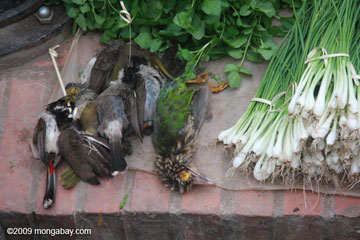 Songbirds sold in a Laos market for food. Photo by: Rhett A. Butler. |
In the struggle to save these species from the illegal trade, officials are being out-witted and out-funded by sophisticated smugglers who employ
the newest technology, clever techniques, and corruption to avoid arrest. Perhaps, even more importantly, wildlife crime is simply not seen as a priority in many parts of the world, where enforcement is lacking and laws are out-of-date.
“The trade is large-scale and commercialized: elaborate and costly hidden compartments in shipping containers or below wholesale shipments of sawn timber, fish or scrap products, in which are concealed massive quantities of wildlife products from ivory to bear paws and frozen pangolins. The traders are also light on their feet, frequently changing routes and modes of operation as enforcement commences in any one place, and continually working through the routes and means of least resistance. […] Trade through e-commerce from web sites whose location is difficult to detect and who operate beyond
the current realms of wildlife legislation and enforcement is a further challenge,” Bennett, who began her career in conservation more than 25 years ago in Asia, writes in the paper. She now works for Wildlife Conservation Society (WCS).
Bennett says the ultimate responsibility for this wholesale decimation of species is due to rising demand for wildlife products in countries like China, Vietnam, and Thailand. In many cases consumers are paying high prices for illegal wildlife products which they believe are curatives. However scientists have shown that animal parts such as rhino horns have no medicinal benefits whatsoever.
According to Bennett there is only one way to stop the criminal activity in time to save species from extinction: law enforcement.
“Enforcement is critical: old fashioned in concept but needing increasingly advanced methods to challenge the ever-more sophisticated methods of smuggling. When enforcement is thorough, and with sufficient resources and personnel, it works,” she writes. Although ‘old-fashioned’ Bennett says tools such as DNA testing kits, smartphone apps for species ID, and high-tech software for Internet crime need to be employed.
Currently enforcement is especially lacking along trade routes and in markets. In many parts of Southeast Asia one can finds illegal wildlife parts sold openly with no fear of punishment.
“We must dedicate the intellectual, funding and personnel resources needed to supersede those of the
criminal organizations involved,” she writes. “This requires greatly increased numbers of highly trained and well equipped staff
at all points along the trade chain: most especially in core sites where the species are being hunted but also along key transportation routes and in end markets.”
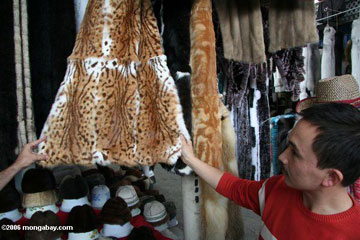 Dealer shows off coats of wild cats in market in China. Photo by: Rhett A. Butler. |
Laws that were crafted before the current crisis of the illegal trade also must be updated.
Bennett says that changing the cultural beliefs that prop up this illegal trade should pursued, but laments that such changes ‘is likely to be on a generational time scale.’
“We do not have that luxury of time for many of the species
currently targeted by trade,” she explains. “In the short-term the only
practical way to reduce demand is through enforcement,
both acting as a deterrent and also demonstrating that this
is not a socially acceptable norm,” Bennett writes.
In the end, the survival of elephants, tigers, and rhinos, along with innumerable other species, depends on law enforcement, the judiciary, governments, NGOs, and the public coming together to tackle the below-the-radar problem.
“Unless we start taking wildlife crime seriously and allocating the commitment of resources appropriate to tackling sophisticated, well-funded, globally-linked criminal operations, population of some of the most beloved but economically prized, charismatic species will continue to wink out across their range, and, appallingly, altogether,” Bennett warns.
CITATION: Elizabeth L. Bennett. Another inconvenient truth: the failure of
enforcement systems to save charismatic species. Oryx. doi:10.1017/S003060531000178X.
Related articles
A message to poachers: Kenya burns elephant ivory stockpile
(07/21/2011) Yesterday the president of Kenya, Mwai Kibaki, sent a fiery signal to illegal wildlife traffickers worldwide. Kibaki lit up five tons of elephant ivory, worth $16 million on the black market, to show the continent’s resolve to undercut illegal poaching. This was the second time Kenya has set fire to millions of dollars worth of ivory.
‘Trophy’ cell phone pictures lead to arrests of tiger poachers
(07/14/2011) Two poachers were arrested in Thailand after a cell phone they left behind in the forest provided evidence of tiger poaching, reports the Wildlife Conservation Society (WCS).
(07/08/2011) Nearly 200 rhinos have been killed in South Africa through the first six months of 2011, reports TRAFFIC, the wildlife trade monitoring network.
Endangered Madagascar wildlife on sale in Thailand

(06/19/2011) Conservation group TRAFFIC uncovered nearly 600 Madagascar reptiles and amphibians on sale in Thai markets, including endangered species and those banned for sale by the Convention on International Trade in Endangered Species of Wild Fauna and Flora (CITES). The animals, representing 24 reptiles species and 9 amphibians, are being sold for the international pet trade.
“We know there is a significant ongoing illegal trade in protected species from Madagascar, mainly destined for Asia, which has been exacerbated by the current political situation in the country leading to weaker enforcement of existing laws and safeguarding of protected areas,” says Richard Hughes, WWF’s Representative in Madagascar.
Traditional Chinese medicine trade takes toll on Indonesia’s geckos
(06/01/2011) The call of the tokek, or gecko, is one of the most familiar sounds in Indonesia. Next to the smell of clove cigarettes, the calls to prayer, the friendly smiles and the ferocious afternoon rainstorms, it stands as one of the most easily identifiable characteristics of the country.
China failing commitment to save tigers
(05/20/2011) Chinese Premier Wen Jiabao pledged that China would work with other nations to end the trade in tiger parts and revive tiger populations at the Global Tiger Forum last fall, but the country has since fallen short of its commitments, says an environmental group.
Bear bile trade, both legal and illegal, ubiquitous in Asia
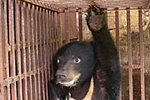
(05/16/2011) Surveying 13 nations and territories in Asia, the wildlife trade organization TRAFFIC found that the bear bile trade remains practically ubiquitous in the region. In many cases the trade, which extracts bile from captive bears’ gall bladders for sale as a pharmaceutical, flouts both local and international law, including Appendix I of Convention on International Trade in Endangered Species of Wild Fauna and Flora (CITES ).
Belief and butchery: how lies and organized crime are pushing rhinos to extinction
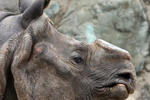
(05/11/2011) Few animals face as violent, as well organized, and as determined an enemy as the world’s rhinos. Across the globe rhinos are being slaughtered in record numbers; on average more than one rhino is killed by poachers everyday. After being shot or drugged, criminals take what they came for: they saw off the animal’s horn. Used in Traditional Chinese Medicine, which claims that it has curative properties, rhino horn is worth more than gold and cocaine on the black market. However, science proves all this cash and death is based on a lie. ‘There is no medicinal benefit to consuming rhino horn. It has been extensively analyzed in separate studies, by different institutions, and rhino horn was found to contain no medical properties whatsoever,’ says Rhishja Larson.
Customs officials confiscate over a thousand monitor lizards headed to China
(04/11/2011) Thai Customs officials have confiscated 1,800 Bengal monitor lizards on the border between Thailand and Malaysia, reports the AFP. Officials said the lizards were likely headed to China for consumption.
95% of Liberia’s elephants killed by poachers
(01/24/2011) Since the 1980s, Liberia has lost 19,000 elephants to illegal poaching, according to Patrick Omondi of the Kenya Wildlife Service speaking in Monrovia, the capital of Liberia. The poaching of Liberia’s elephants has cut the population by 95% leaving only 1,000 elephants remaining.
Last year worst yet for rhino killings in South Africa
(01/19/2011) Three hundred and thirty-three rhinos were killed in South Africa last year, the highest number yet. Ten of the rhino were black rhinos, which are listed as Critically Endangered by the IUCN Red List, the rest were white rhinos, listed as Near Threatened. In total South Africa has over 20,000 rhinos.
Wildlife crime goes largely unpunished in Indonesia
(01/10/2011) Indonesia is famed for its wildlife diversity. Straddling the contact zone between Asia and Australia, evolution has created some of the earth’s most remarkable species here. Think babirusa , Komodo dragon, orangutan and birds of paradise, and you get the picture. Indonesia is famed for its wildlife diversity. Straddling the contact zone between Asia and Australia, evolution has created some of the earth’s most remarkable species here. Think babirusa, Komodo dragon, orangutan and birds of paradise, and you get the picture. Most of us also know that Indonesia has a major problem maintaining this diversity through effective conservation programs. Not a day goes by without Indonesia appearing somewhere in the world’s media with a negative story on how it is managing its wildlife.
Malaysian customs seizes 1,800 trafficked reptiles
(01/04/2011) Malaysia ended 2010 with the confiscation of 4.3 metric tons of reptiles near the Thai border on December 20th, reports the Wildlife Trade Monitoring Network, TRAFFIC. The confiscation was the largest of the year and consisted of over 1,800 monitor lizards, snakes, freshwater turtles, and tortoises.